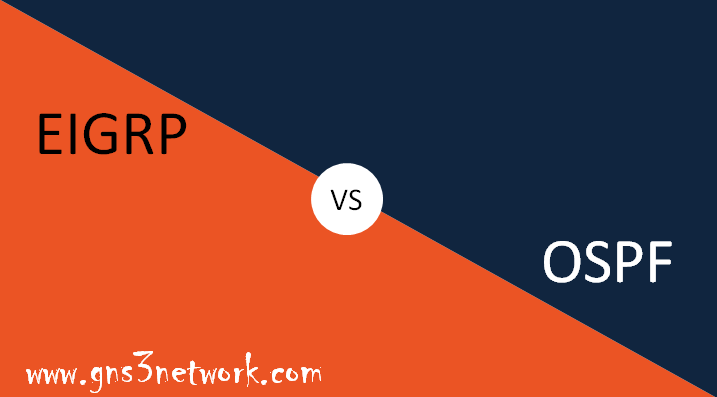In this article, we will discuss some common differences between EIGRP & OSPF. Both are dynamic routing protocols and both have their pros and cons. If you are new to the dynamic routing protocols, I recommend you to go through the EIGRP & OSPF, it will help you to understand the below differences. Let’s start!

Key Differences: EIGRP vs OSPF
- EIGRP stands for Enhanced Interior Gateway Routing Protocol & OSPF stands for Open Shortest Path first.
- EIGRP is a Hybrid Routing Protocol having the features of both Distance Vector and Link State Routing Protocols. However, OSPF is a link-state routing protocol.
- EIGRP is a Cisco Proprietary Routing Protocol, but OSPF is standardized by the Internet Engineering Task Force (IETF).
- EIGRP uses a combination of Bandwidth, Load, Total Delay, Reliability, MTU, and Hop Count as its metric. OSPF uses the Path Cost as its metric.
- EIGRP is the only routing protocol, that supports unequal cost load balancing. However, OSPF only supports equal-cost load balancing.
- The Administrative Distance (AD) Value of EIGRP is 90 & 170 (Internal & External). OSPF AD value is 110.
- EIGRP Uses Diffused Update Algorithm (DUAL) to calculate the best route. However, OSPF uses the Dijkstra Algorithm to calculate the best path.
- EIGRP Multicast address is 224.0.0.10 & OSPF Multicast addresses are 224.0.0.5 & 224.0.0.6.
- EIGRP uses a feasible successor as a backup path for the destination networks. So, the Convergence time is very less as compared with OSPF.
Note: In some cases of EIGRP, convergence can be almost instant
Now, let’s recap all the differences between EIGRP and OSPF.
[table id=14 /]
Download: EIGRP vs OSPF
Related Articles
- EIGRP: The complete guide for Beginner and Expert
- OSPF | Open Shortest Path First | Quick Overview
- Download Cisco Packet Tracer
- Download GNS3 Latest Version
- Dynamic Routing: A Complete Guide
- OSPF Neighborship States
Summary
Well, in this article, we have discussed approx 10 differences between EIGRP & OSPF. No doubt, both routing protocols are very good for medium to large-scale enterprises. However, the use of one of the routing protocols depends on various factors such as device hardware, capabilities, support, etc.
Did you found this article helpful? Please give your suggestions in the comment box!